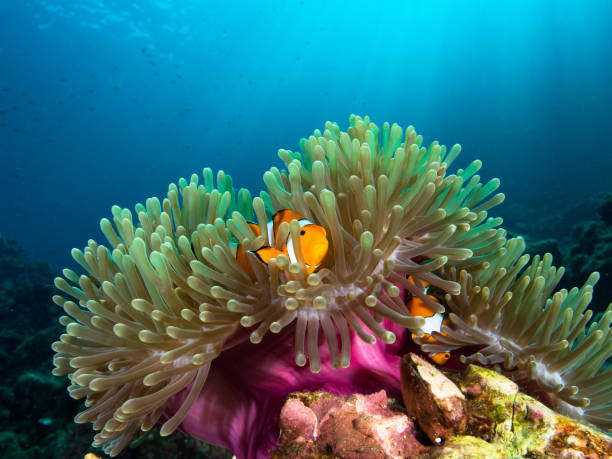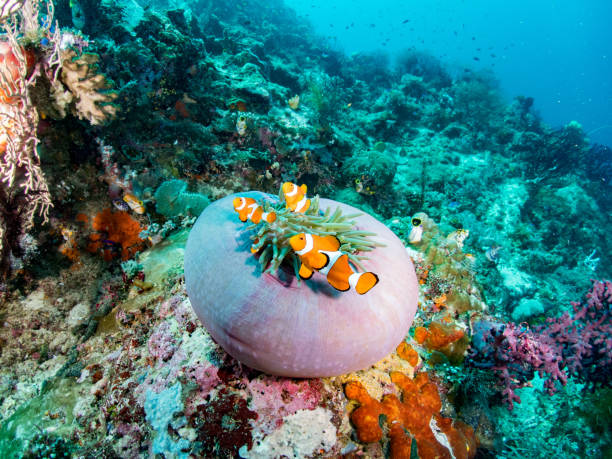How Often to Feed Clownfish: Schedule, Amount & Best Food
A clownfish is a small, brightly colored fish that is found in warm oceans around the world. They are popular as aquarium fish because of their playful and entertaining behavior. Clownfish eat small fish, crustaceans, and other invertebrates. They are generally easy to keep and require little care, but they do need to be fed occasionally.
Some clownfish owners feed their fish once a day, while others give them feeders that they can access several times a day. The best way to determine how often your clownfish needs feeding is to observe its behavior and see when it becomes active and interested in food.
Table of Contents
How Much Food to Feed Your Clownfish?
The amount of food to feed a clownfish will vary depending on the size and age of the fish. Generally, clownfish should be fed once a day, but smaller fish may need to be fed every other day or even once a week while larger fish can be fed every few days. Clownfish are tropical fish that require a lot of food to survive. A healthy clownfish will eat every day, but you may only need to feed them once a week. Feed them a high-quality diet of live and frozen foods.

What Are the Best Food for Clownfish?
Clownfish are omnivorous and will eat a variety of food items, including small invertebrates, plant material, and even other fish. Clownfish are typically fed a diet of live food once a day, but can also be fed frozen or canned food. Some of the best foods for clownfish include live brine shrimp, krill, and freeze-dried food. Some clownfish also enjoy algae wafers and spirulina tablets, but be sure to check the ingredients list before giving them to your fish as some of these items may contain harmful chemicals.
Pellets/Flake
Pellets/flake food is a great option for clownfish as it provides a high-quality diet that is easy to feed. Pellets/flake food comes in many different flavors and can be easily sprinkled into the fish’s tank. You can also mix pellets with live or frozen foods to create a varied diet for your clownfish.
Frozen Food
Many clownfish enjoy frozen food as a source of nutrition. Frozen foods come in many different flavors and can be easily mixed with live or pellets to create a varied diet. Some great options include:
- Bloodworm: Bloodworms are high-quality protein and contain essential vitamins and minerals that are beneficial to the clownfish’s health. This type of food is best-fed freeze-dried, not alive.
- Krill: Krill is a high-quality protein source that contains all of the essential nutrients clownfish need. Offer frozen krill in various flavors such as garlic, lime, and peach for added excitement in your fish’s life.
- Celery: Celery is a good option for those seeking complete nutrition as it provides essential vitamins and minerals including Vitamin A and C.
Dried Food
Dried foods offer a high-quality and varied diet for clownfish. Some great options include:
- Spirulina: Spirulina is a high-quality food that is rich in protein, minerals, and vitamins. It can be fed dry as well as mixed with other dried treats to make a balanced diet for your fish.
- Mysis Shrimp: Dried Mysis larvae can be fed as a source of carbohydrates for your clownfish. Dried shrimp also provide essential fatty acids and protein to the fish’s diet, as well as many other vitamins; some brands even come with minerals such as iron.
Live Food
Live food offers a rich and exciting diet for clownfish. Some great options include:
- Cricket Nymphs: Cricket nymphs are small creatures that live near the water’s surface. They are high in protein and provide essential nutrients to your fish, as well as entertainment.
- Live brine shrimp: Live foods such as live fine brine shrimp can be fed to clownfish along with other fish feeders; they contain essential nutrients from microscopic algae that aid in digestion. If you’re new to this type of food, start by feeding freshwater quality stapled or foam flaked supplies directly into the tank.

How to Feed Your Clownfish?
When it comes to feeding your clownfish, there is no one-size-fits-all answer. However, there are a few things you can do to help ensure your fish is getting the sustenance it needs.
One option is to feed your clownfish small pieces of fresh seafood every day. This can include things like shrimp, fish, and crayfish. Make sure to clean the food before feeding it to your fish, as Clownfish are notorious for eating parasites and other harmful organisms.
Another option is to set up a feeding station consisting of floating food and live plants. This will provide your clownfish with a variety of different foods and will also help keep the tank clean. Whatever you do, always make sure to keep a close eye on your clownfish’s health and adjust the feeding schedule as needed.
Feeding your clownfish can be a little intimidating at first, but with a little preparation and some patience, it becomes easy. Here are some tips to get you started:
- Start by mixing all of the food items into one container before putting them in the tank. This will help keep everything clean and organized.
- Add food as often as possible during feeding times; once every two hours is usually sufficient.
- Be patient; some clownfish may take a little longer to adjust to new food sources.
Can You Overfeed Clownfish?
Clownfish are avid eaters and tend to consume excessive amounts of food if given the opportunity. This can lead to digestive issues such as diarrhea and malnutrition. If you notice that your clownfish is eating more than it should, try decreasing the amount of food offered each day or reducing the amount of food the fish is offered in a week.
How Long Can Clownfish Survive Without Food?
A clownfish can survive for up to days up to a week without food, provided their water is clean and they have a good supply of aquarium rocks and coral to cling onto. If the water becomes dirty or if the clownfish does not have any other places to hide, they may quickly become sick and die.
If your clownfish do not eat for a few days or weeks, it is important to check their water quality and make sure nothing is blocking their digestive system. If the water quality remains poor, you may need to feed them small amounts of frozen foods or live brine shrimp.
Alternative Food Sources for Clownfish
Clownfish are tropical fish that require a lot of food to thrive. A typical diet for a clownfish includes small fish, algae, and insects. If your clownfish is not getting the food it needs, you may need to provide an alternate food source. Some alternative food sources for clownfish include frozen foods, live foods, and prepared aquarium diets.